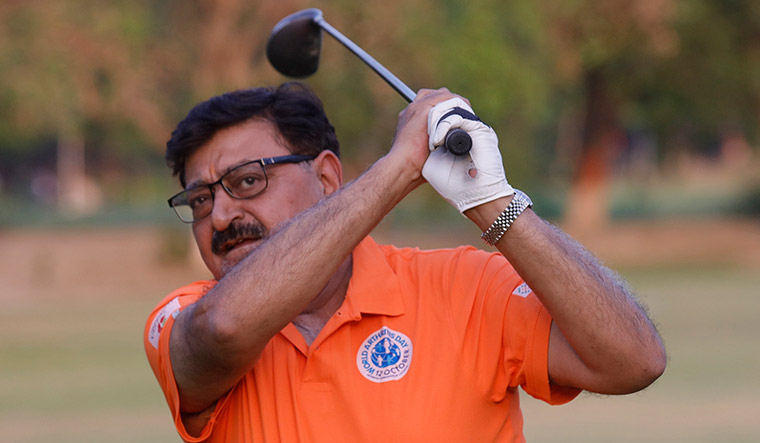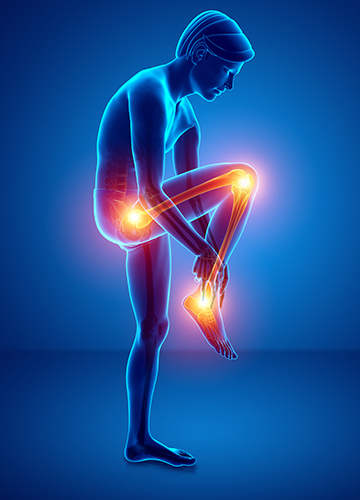Dr Sandeep Kapoor calls himself a docpreneur. The orthopaedic surgeon specialises in trauma and joint replacement surgery. He did his MS from King George’s Medical University, Lucknow, and is a DNB, and the recipient of many prestigious fellowships. Dr Kapoor worked in the not-for-profit and the corporate sectors before co-founding the Health City Hospital in Lucknow, and is in the process of setting up another 300-bed hospital. An avid listener of podcasts, he is also a golf enthusiast.
Essentials about bone health: The human body is made up of the musculoskeletal system. The skeletal part is the bone, and the surrounding is the musculature. Bone health encompasses bones and muscles; and the point at which two bones join each other―joints. For an infant on mother’s milk, it is a sufficient diet that provides calcium for the growth and nutrition of bones. Adequate diet is important right from childhood. Drinking pasteurised milk (without boiling), using iodised salt are some of the habits we have always followed. It is also important to get adequate sunlight. The other important component is activity. Body movements with pressure stimulate growth.
As we grow: Medicines do not have a large part to play in bone growth and health, but habits, nutrition and lifestyle do. Alcohol will harm you. Red meat eaters could have high uric acid levels, which will in turn lead to joint pain and further harm the joints. Wrong posture can lead to head and neck pain. Till the age of 40, the calcium we intake and the calcium in the bones maintain a kind of equilibrium, but post that, calcium from the bones starts to deplete; and muscles begin to waste.
The start of trouble: Some people will be genetically predisposed to rheumatoid arthritis. This is a long-lasting auto-immune condition in which the body’s defence mechanism attacks its own tissues leading to pain, swelling and stiffness. Other kinds of arthritis might manifest in certain people without warning signs and we cannot prevent them.
Three broad challenges: Calcium (and vitamin D) deficiency in children leads to rickets; in adults to osteomalacia; and when bone mass begins to fall it leads to osteoporosis which changes the strength and structure of bones.
What we can control: Every particular height and body structure is made for certain loading. Excess load will lead to both joint and bone pain. Thus having control over one’s weight is very important.
Calcium supplements: It is a myth that every fracture needs calcium. If a fracture is caused by say an injury, then it does not. Calcium would be more relevant for weak bones. Thus, underlying pathological causes need identification before prescribing any supplement. Ideally, one’s diet should be adequate to provide the body with the essential vitamins and minerals. The challenge is to identify the deficiency points in one’s diet.
Is lactose intolerance a myth? No, it is not, but how many people have been diagnosed as such? On the other hand, take up any (prescribed) diet these days, it will have no milk because milk is calorie dense. We see calcium deficiency more in urban patients because for the rural population which has cattle, milk is still an important part of the diet.
Vitamin D deficiency: This is definitely not because of the lack of sunlight but we have not been able to pin point the reason behind it. Vitamin D is essential for absorption of calcium. How much one requires depends on age and stage (lactating mother versus post-menopausal woman, for instance). When given as a combination with calcium, it is for maintenance. In case of deficiency, it is prescribed separately in pure, heavy quantities according to international standards. But there are various schools of thought among endocrinologists, paediatrics and ortho-physicians about how this is to be given―in low doses every day, alternate days or in weekly doses. Expert advice is essential because vitamin D toxicity is real.
The role of genetics: If a mother has osteoarthritis, offspring will have a predisposition to it, but this is not proven. There are certain genetic bone syndromes that are beyond what we are discussing here.
The gender differential: Menopausal women are at risk for osteoporosis and osteoarthritis―two conditions that are often incorrectly understood. Osteoarthritis, which I have seen almost always in women, is age related arthritis of the weight bearing joints. In the west, this mostly affects the hips; while in India it is the hands and knees that bear the brunt. Osteoporosis is a condition where the bones are weak and prone to breaking and fracturing easily. It is common in post-menopausal women because of falling levels of oestrogen. (According to some studies, women lose 10 per cent of their bone mass in the first five years after menopause). Pregnancy, lactation, menopause all contribute. Recovery in male patients is much faster than female patients, probably because their bones are stronger to start with.
High life expectancy, more fractures: Age-related fractures are like an epidemic with increasing life expectancy. This is not just a health problem but also a socioeconomic one as not everyone in the growing elderly population has an insurance. Expensive implants, keeping these patients in critical care and monitoring them while family members are busy―all of these are challenges.
Understand activity right: What we do in our daily life as part of everyday chores or our jobs does not count as activity as the body is used to it. There are two parts to it―activity for the muscoskeletal system and for lung health; or weight training and cardio. Yoga is very good. For the heart, 45 minutes to an hour of walking is essential. This helps the heart to develop more vessels to pump better. Let us say we get a 40-year-old patient who has difficulty climbing the stairs. His cardiologist and his diabetes doctor have asked him to walk. Arthritis patients have no problems in straight-walking, it is elevation they find difficult. Thus, activity should be in tune with orthopaedic condition. Activity becomes a problem when you disregard your orthopaedic reality. If you are turning 60 and have never jumped in your life, and suddenly decide to do high-jumps, remember your body is not tuned for it. On the other hand, one who has been a marathon runner will be able to run till the age of 90 and beyond.
We hear of so many deaths during/post gym workouts. That is possibly because people are pumping huge amounts of weight but the body is not used to the sudden increase in the musculature of the heart. I am also a strong proponent of activities for mental fitness for while people might have healthy bodies, their minds are not healthy.
Balance is the key: As we age we tend to lose muscle strength and put on fat. There are fads such as intermittent fasting where people are accelerating this muscle loss, while the focus should be on losing fat. If you are doing your mandatory 45-60 minutes of brisk walking but following it up with a fat rich breakfast and partying till late in night, you are undoing all the good. Excess of anything is bad. Pain and fatigue are very important deciding factors for what our bodies are meant for.
Pointers other than pain: Fatigue and lethargy are indicators that something is wrong. Drop in alertness, fall in energy, lack of sleep or too much sleep are also indications that something is wrong. Weak neck muscles, for example, can lead to headaches. So we ask the patient to build neck muscles. Similarly if you were once able to climb steps easily but not anymore, build quad muscles with advice from a trained specialist.
The various stages of problems: Stage one and two might have very mild problems such as occasional pain, which you might notice only if very careful. It will not show up in X ray findings. In the first, mild painkillers will work. In the second these will be supplemented by physiotherapy.
Knee replacement surgery: Come stage three and the symptoms become obvious―walking with a waddle or a duck like gait, having bow legs, knock knees or other deformities. Such patients are in constant pain and might have difficultly even using the washroom. When lifestyle modifications, physiotherapy, medicines, precautions and external support all fail, patients require replacement surgery. Some expensive joint health supplements (collagen peptides, glucosamine, C supplement) are available and might help.
Knee problems are epidemic: Particularly in females (caused by all the factors discussed above and made worse by longer life spans). Replacement surgery is a well-accepted procedure and understood by lay persons. Its success has also been well demonstrated.
The use of AI: In medicine, AI should be used where the human eye cannot see or cannot see very clearly―such as cancer of the prostate sitting behind a bone. For knee and hip there will be selective indications for use of AI. We have been using everything from computer navigation to robots. AI has its limitations in a country like India where people are unable to get a knee replacement even in the most conventional form.
Myth that surgery is very expensive: Not really, but big players have jacked up costs. We need the government’s support to bring these down. Government hospitals are conducting a high volume of knee replacement surgeries. There is also a government fixed ceiling on the cost of implants.
Rehabilitation period: Results and down time depend on timing of surgery. Hospital stay is generally between three to five days. If a patient comes with functional problems, before the bone on bone stage, the muscles have not deteriorated and recovery is faster. Timing is important. Joint surgery should happen ideally just once in a lifetime. Revision surgery is mutilating and results are unpredictable.
Quality of life: While it does come back to normal, you will not become an athlete. You will not be running, but you will easily be able to walk three to five kilometres a day. Remember, this is tied in with the age of the patient.
The next epidemics: Patients who have had a knee replacement surgery and lived on for 20-25 years will need replacement surgeries. Peri prosthetic fractures―those that happen around joint replacements―will also come in. There is nothing patients can do to prevent these.
An ideal patient: One who is in the 60s. If your quality of life is extremely compromised, do not wait till 60. When everything else has failed, such a patient should ideally come to you walking and not in a wheelchair (which indicates poor muscle strength).
Common risks: If a patient has been not walking for long, there might be deep vein thrombosis (DVT) wherein s/he gets blood clots in the limbs from which they can go to any other part of the body and lead to strokes or cardiac arrest. However, prophylaxis are given for these conditions and it rarely comes up as a challenge in surgery. A bigger concern are infections. That is the reason the patient should find out the number of surgeries being done in that centre and if the infrastructure is designed to minimise infections.



